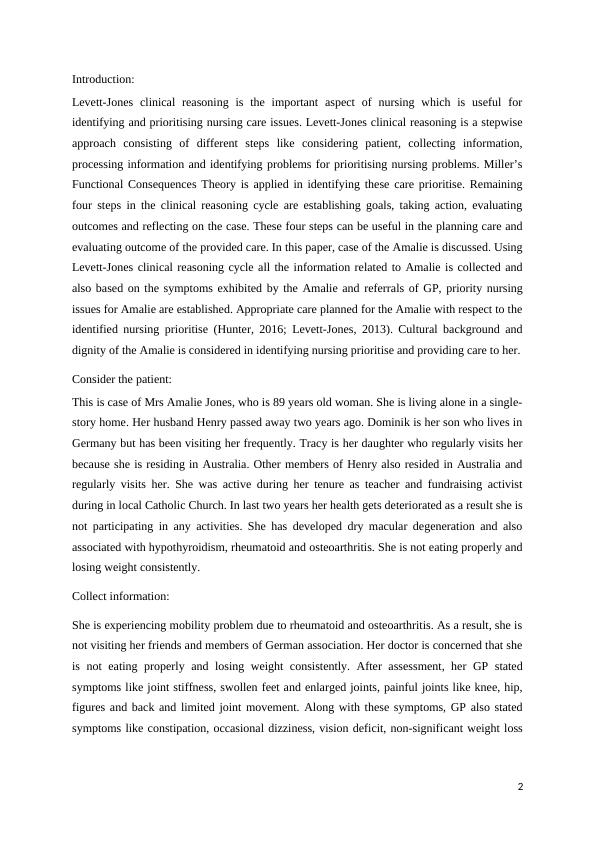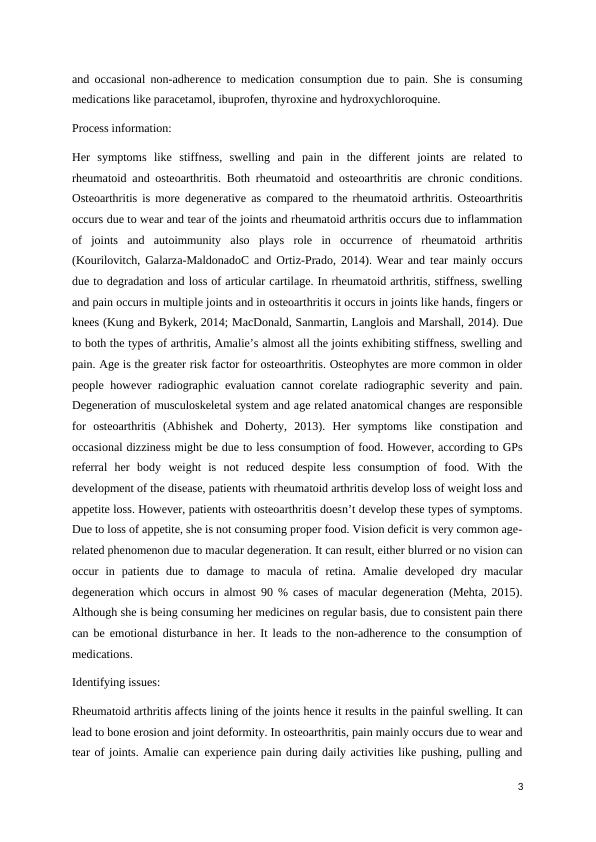Levett-Jones Clinical Reasoning Cycle: A Case Study on Nursing Prioritization
Added on 2023-06-14
8 Pages3017 Words492 Views
Case Study
1
1

Introduction:
Levett-Jones clinical reasoning is the important aspect of nursing which is useful for
identifying and prioritising nursing care issues. Levett-Jones clinical reasoning is a stepwise
approach consisting of different steps like considering patient, collecting information,
processing information and identifying problems for prioritising nursing problems. Miller’s
Functional Consequences Theory is applied in identifying these care prioritise. Remaining
four steps in the clinical reasoning cycle are establishing goals, taking action, evaluating
outcomes and reflecting on the case. These four steps can be useful in the planning care and
evaluating outcome of the provided care. In this paper, case of the Amalie is discussed. Using
Levett-Jones clinical reasoning cycle all the information related to Amalie is collected and
also based on the symptoms exhibited by the Amalie and referrals of GP, priority nursing
issues for Amalie are established. Appropriate care planned for the Amalie with respect to the
identified nursing prioritise (Hunter, 2016; Levett-Jones, 2013). Cultural background and
dignity of the Amalie is considered in identifying nursing prioritise and providing care to her.
Consider the patient:
This is case of Mrs Amalie Jones, who is 89 years old woman. She is living alone in a single-
story home. Her husband Henry passed away two years ago. Dominik is her son who lives in
Germany but has been visiting her frequently. Tracy is her daughter who regularly visits her
because she is residing in Australia. Other members of Henry also resided in Australia and
regularly visits her. She was active during her tenure as teacher and fundraising activist
during in local Catholic Church. In last two years her health gets deteriorated as a result she is
not participating in any activities. She has developed dry macular degeneration and also
associated with hypothyroidism, rheumatoid and osteoarthritis. She is not eating properly and
losing weight consistently.
Collect information:
She is experiencing mobility problem due to rheumatoid and osteoarthritis. As a result, she is
not visiting her friends and members of German association. Her doctor is concerned that she
is not eating properly and losing weight consistently. After assessment, her GP stated
symptoms like joint stiffness, swollen feet and enlarged joints, painful joints like knee, hip,
figures and back and limited joint movement. Along with these symptoms, GP also stated
symptoms like constipation, occasional dizziness, vision deficit, non-significant weight loss
2
Levett-Jones clinical reasoning is the important aspect of nursing which is useful for
identifying and prioritising nursing care issues. Levett-Jones clinical reasoning is a stepwise
approach consisting of different steps like considering patient, collecting information,
processing information and identifying problems for prioritising nursing problems. Miller’s
Functional Consequences Theory is applied in identifying these care prioritise. Remaining
four steps in the clinical reasoning cycle are establishing goals, taking action, evaluating
outcomes and reflecting on the case. These four steps can be useful in the planning care and
evaluating outcome of the provided care. In this paper, case of the Amalie is discussed. Using
Levett-Jones clinical reasoning cycle all the information related to Amalie is collected and
also based on the symptoms exhibited by the Amalie and referrals of GP, priority nursing
issues for Amalie are established. Appropriate care planned for the Amalie with respect to the
identified nursing prioritise (Hunter, 2016; Levett-Jones, 2013). Cultural background and
dignity of the Amalie is considered in identifying nursing prioritise and providing care to her.
Consider the patient:
This is case of Mrs Amalie Jones, who is 89 years old woman. She is living alone in a single-
story home. Her husband Henry passed away two years ago. Dominik is her son who lives in
Germany but has been visiting her frequently. Tracy is her daughter who regularly visits her
because she is residing in Australia. Other members of Henry also resided in Australia and
regularly visits her. She was active during her tenure as teacher and fundraising activist
during in local Catholic Church. In last two years her health gets deteriorated as a result she is
not participating in any activities. She has developed dry macular degeneration and also
associated with hypothyroidism, rheumatoid and osteoarthritis. She is not eating properly and
losing weight consistently.
Collect information:
She is experiencing mobility problem due to rheumatoid and osteoarthritis. As a result, she is
not visiting her friends and members of German association. Her doctor is concerned that she
is not eating properly and losing weight consistently. After assessment, her GP stated
symptoms like joint stiffness, swollen feet and enlarged joints, painful joints like knee, hip,
figures and back and limited joint movement. Along with these symptoms, GP also stated
symptoms like constipation, occasional dizziness, vision deficit, non-significant weight loss
2

and occasional non-adherence to medication consumption due to pain. She is consuming
medications like paracetamol, ibuprofen, thyroxine and hydroxychloroquine.
Process information:
Her symptoms like stiffness, swelling and pain in the different joints are related to
rheumatoid and osteoarthritis. Both rheumatoid and osteoarthritis are chronic conditions.
Osteoarthritis is more degenerative as compared to the rheumatoid arthritis. Osteoarthritis
occurs due to wear and tear of the joints and rheumatoid arthritis occurs due to inflammation
of joints and autoimmunity also plays role in occurrence of rheumatoid arthritis
(Kourilovitch, Galarza-MaldonadoC and Ortiz-Prado, 2014). Wear and tear mainly occurs
due to degradation and loss of articular cartilage. In rheumatoid arthritis, stiffness, swelling
and pain occurs in multiple joints and in osteoarthritis it occurs in joints like hands, fingers or
knees (Kung and Bykerk, 2014; MacDonald, Sanmartin, Langlois and Marshall, 2014). Due
to both the types of arthritis, Amalie’s almost all the joints exhibiting stiffness, swelling and
pain. Age is the greater risk factor for osteoarthritis. Osteophytes are more common in older
people however radiographic evaluation cannot corelate radiographic severity and pain.
Degeneration of musculoskeletal system and age related anatomical changes are responsible
for osteoarthritis (Abhishek and Doherty, 2013). Her symptoms like constipation and
occasional dizziness might be due to less consumption of food. However, according to GPs
referral her body weight is not reduced despite less consumption of food. With the
development of the disease, patients with rheumatoid arthritis develop loss of weight loss and
appetite loss. However, patients with osteoarthritis doesn’t develop these types of symptoms.
Due to loss of appetite, she is not consuming proper food. Vision deficit is very common age-
related phenomenon due to macular degeneration. It can result, either blurred or no vision can
occur in patients due to damage to macula of retina. Amalie developed dry macular
degeneration which occurs in almost 90 % cases of macular degeneration (Mehta, 2015).
Although she is being consuming her medicines on regular basis, due to consistent pain there
can be emotional disturbance in her. It leads to the non-adherence to the consumption of
medications.
Identifying issues:
Rheumatoid arthritis affects lining of the joints hence it results in the painful swelling. It can
lead to bone erosion and joint deformity. In osteoarthritis, pain mainly occurs due to wear and
tear of joints. Amalie can experience pain during daily activities like pushing, pulling and
3
medications like paracetamol, ibuprofen, thyroxine and hydroxychloroquine.
Process information:
Her symptoms like stiffness, swelling and pain in the different joints are related to
rheumatoid and osteoarthritis. Both rheumatoid and osteoarthritis are chronic conditions.
Osteoarthritis is more degenerative as compared to the rheumatoid arthritis. Osteoarthritis
occurs due to wear and tear of the joints and rheumatoid arthritis occurs due to inflammation
of joints and autoimmunity also plays role in occurrence of rheumatoid arthritis
(Kourilovitch, Galarza-MaldonadoC and Ortiz-Prado, 2014). Wear and tear mainly occurs
due to degradation and loss of articular cartilage. In rheumatoid arthritis, stiffness, swelling
and pain occurs in multiple joints and in osteoarthritis it occurs in joints like hands, fingers or
knees (Kung and Bykerk, 2014; MacDonald, Sanmartin, Langlois and Marshall, 2014). Due
to both the types of arthritis, Amalie’s almost all the joints exhibiting stiffness, swelling and
pain. Age is the greater risk factor for osteoarthritis. Osteophytes are more common in older
people however radiographic evaluation cannot corelate radiographic severity and pain.
Degeneration of musculoskeletal system and age related anatomical changes are responsible
for osteoarthritis (Abhishek and Doherty, 2013). Her symptoms like constipation and
occasional dizziness might be due to less consumption of food. However, according to GPs
referral her body weight is not reduced despite less consumption of food. With the
development of the disease, patients with rheumatoid arthritis develop loss of weight loss and
appetite loss. However, patients with osteoarthritis doesn’t develop these types of symptoms.
Due to loss of appetite, she is not consuming proper food. Vision deficit is very common age-
related phenomenon due to macular degeneration. It can result, either blurred or no vision can
occur in patients due to damage to macula of retina. Amalie developed dry macular
degeneration which occurs in almost 90 % cases of macular degeneration (Mehta, 2015).
Although she is being consuming her medicines on regular basis, due to consistent pain there
can be emotional disturbance in her. It leads to the non-adherence to the consumption of
medications.
Identifying issues:
Rheumatoid arthritis affects lining of the joints hence it results in the painful swelling. It can
lead to bone erosion and joint deformity. In osteoarthritis, pain mainly occurs due to wear and
tear of joints. Amalie can experience pain during daily activities like pushing, pulling and
3

End of preview
Want to access all the pages? Upload your documents or become a member.
Related Documents
Levett-Jones Clinical Reasoning Cycle for Nursing Care Prioritization: A Case Study of Amalielg...
|7
|2623
|101
Promoting Health in Extended Carelg...
|8
|2888
|435
Promoting Health in Extended Carelg...
|8
|2885
|293
Promoting Health in Extended Carelg...
|10
|2774
|290
Designing an Effective Nursing Care Plan for an Aged Personlg...
|9
|2914
|74
Case Study of Mrs. Jones: Clinical Reasoning Cycle and Miller's Functional Consequences Theorylg...
|9
|2646
|296